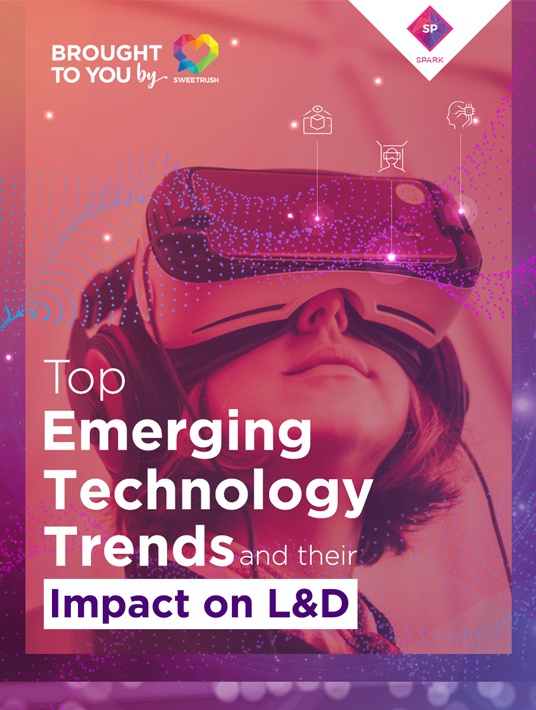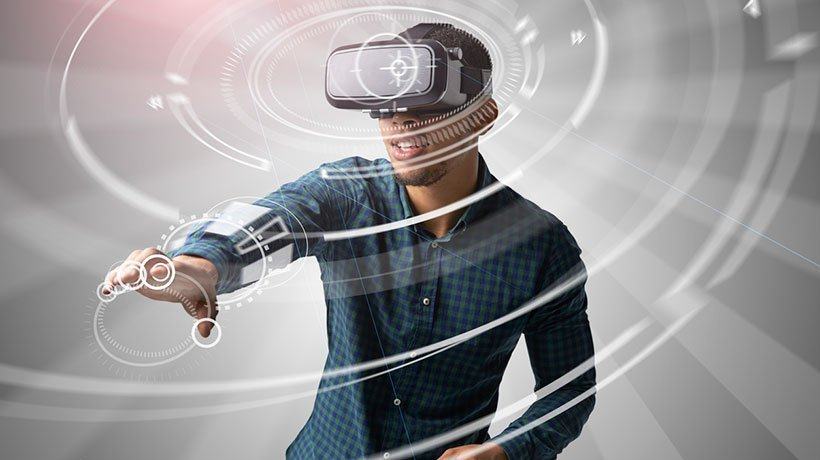How Innovative Technologies Can Have An Unprecedented Positive Influence On L&D
There is an abundance of exciting opportunities to explore in relation to the ever-changing landscape of L&D. And some great new, emerging technology trends to explore: Virtual Reality, Augmented Reality, and Artificial Intelligence. All of them open up new ways for L&D professionals to do their jobs. Which emerging technologies are reshaping L&D the most? The art is to be able to adapt and take advantage of changing conditions and new technologies instead of attempting to compete with them. Sometimes, change can be intimidating. It involves a complex variety of processes. But, at the same time, it's also inspiring. Moreover, the reward of stepping outside of your comfort zone to begin to change, grow, and transform, is a great one.

About The eBook: Top Emerging Technology Trends And Their Impact On L&D
The eBook addresses several emerging technologies, some of which are dominant in the space. If you take the most well-known and significant emerging technology trend affecting the way we design learning programs, you will soon land upon VR. It is, by far, the most dominant trend in L&D to date, in part because the technology has become affordable. What really makes VR stand out as the perfect learning tool for the workplace is its ability to captivate and allow presence. To be captivated by immersing yourself in an experience and to be present by being psychologically invested in a place and time.
AR superimposes a digital image in a real-world situation. Think of the game 'Pokemon GO'. That was the first mainstream application of AR that grabbed the world's attention. There are a few key differences between VR and AR. Virtual Reality presents us with limitless virtual worlds but as a human in the real world, you are restricted in physical space. However, AR allows for a user to be able to move around unobstructedly. It can improve conventional learning methods by offering a 3D view of objects. Think of medical students studying a 3D model of a heart, then opening it up, zooming in and out of the different parts of the organ. From working with MRI equipment to conducting complicated surgeries, it can be applied to medical training in many areas. It is equally as applicable to:
- Retail
- Tourism business
- Classroom education
- Restoration & preservation
- Design & modeling
- Court service
- Artificial Intelligence
- Business logistics
A big part of L&D is not formal learning; it's what happens on the job. That's where AI comes in. Internet searches and other Performance Support Systems can deliver information to help people learn what they need just in time. If you wish to enable learners to only take part in the training they need to build competencies and skills, AI may be a resolution to this challenge.
With Big Data, large volumes of data can be analyzed in order to excavate insights that guide us towards making better decisions. Within L&D, think about the data that is (or could be) generated when learners interact with technology-based learning programs. Using the training to gather data on how people think, believe, and act, for example, in simulated situations.
Things To Consider Before Implementing Emerging Tech In Your Business
Developing tech-driven learning programs should never lose focus on the most important elements—learners and actual learning. L&D professionals must consider a few things that will determine whether a learning program enabled by emerging tech is the right fit and, if so, which type of technology will be most effective. Emerging technologies are celebrated because they improve conventional education, which allows for better understanding, and because they make it possible to replicate events that would be difficult to repeat.
The outcome of the analysis is a reliable, documented understanding of 'what the immersive learning needs to accomplish', 'who it should be tailored to and how' (often with initial mock-ups or sketches), and 'how immersive learning will work'. You should also look at resources and constraints to determine the best options for equipment and distribution, which have their own complexities with immersive learning.
Learning interventions are always going to be more effective when we begin with the fundamental principles of Instructional Design and User Experience. The designers must have a solid understanding of:
- The business/organizational goals you are trying to achieve
- The target audience (learners)
VR that simulates or links to the learners' work environment, is needed for it to feel as relevant as possible, so it resembles a very significant level of authenticity.
Analysis: A Key Step For Immersive Learning
Tapping the goals, and taking on both perspectives of stakeholders and learners, does take time. Think of it as an up-front investment that will save you time in the end. When you shop for a car, you take into consideration how you will use the car and what features are important to you. The consequence of not taking that time up front means you could end up with a car that doesn't suit your needs. This is why it is suggested that you first retain a low-cost analysis phase for immersive learning projects. The analysis may focus on a series of interviews with stakeholders and learners, or include experiential design-thinking strategy sessions.
The Immersive Virtual Learning Journey
Your new Learning Journey is immersive as ever. With all of the excitement and buzz around emerging technologies, it's easy to forget that VR, AR, and AI are mostly additional tools in our large L&D database. Choosing the right medium has all to do with the primary objectives and audience. Often, the solution with the most influence is not just one type of training, but a blend of different learning procedures. When we design a program, we need to think about learning as a long-lasting mission, rather than a one-time event. Context setting and preparation, knowledge transfer, practice and application, and ongoing reinforcement need to be considered for any type of learning, including immersive. The most effective, impactful program for your learners might include, for example, eLearning or video prework, an instructor-led workshop with a VR or Mixed-Reality component for practice and debrief, a small-group AR cardgame for peer-based learning, an AI virtual assistant for Performance Support or even follow-up coaching sessions.
Not sure about the true impact emerging technologies have on your Learning and Development team's productivity and performance? If you are interested to find out, download the eBook Top Emerging Technology Trends And Their Impact On L&D to discover how the emergence of Virtual Reality and Augmented Reality can open up new ways of working for L&D professionals. Learn why they are new powerful tools in teaching and affecting behavioral change, and how they can help you achieve your business objectives.









